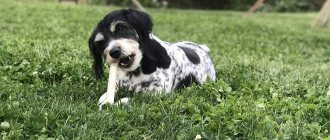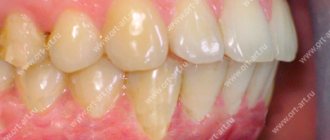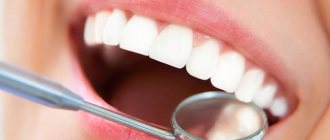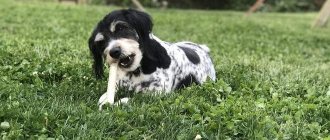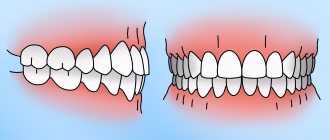Statistical studies based on the results of diagnostic procedures performed in clinical settings show that occlusal deviations occur in the majority of people. Quite often, patients are unaware of the presence of a problem, turning to orthodontists solely out of a desire to improve the aesthetics of their smile, but in fact, the pathological condition can provoke more serious consequences. The correct ratio of the upper and lower rows is characterized by close contact of the antagonists, a small (no more than a third of the height of the crowns) overlap, as well as a natural anatomical arrangement of the elements. Malocclusion, the types of which are classified based on characteristic symptoms, requires proper treatment.
General overview
In dentistry, it is customary to distinguish between dental and skeletal forms of abnormal development of the dentofacial apparatus. In the first case, we are talking about pathological closure caused by incorrect teething, insufficiency or excessive completeness, unnatural dimensions of individual crowns, as well as defects in the formation of the alveolar process. The second category includes problems associated with deviations in the anatomical structure and position of the jaws - their correction requires the use of more radical medical techniques, which is determined by the complexity of the pathology.
Why is it important to fix the problem in time?
Any orthodontic irregularities are potential dental problems in the future.
Improper closure leads to abrasion of the enamel on the cutting edge of the teeth (all or only on one side if the bite is asymmetrical).
When teeth are crowded, it is more difficult to remove plaque - this causes caries, and with insufficient care - gum disease.
If prosthetics are required in the future, placing an implant may not be possible or there may even be restrictions on placing a bridge. So first you will need to correct the position of the remaining teeth.
With severe crowding of teeth and a noticeable narrowing of the jaw, aesthetic problems are added: teeth look unsightly, asymmetry of the lower part of the face may occur.
Treatment by an orthodontist is not an aesthetic procedure. A beautiful smile is what you get as a bonus; the main acquisition is a correct bite and maintaining dental health in the future.
Reasons for development
The classification of dental growth anomalies, as well as types and degrees of malocclusion, allows for a combination of various factors. Both external and internal processes have an impact, from genetic predisposition to bad habits. Differentiation by age makes it possible to identify the main prerequisites characteristic of patients of certain groups.
In childhood
The reasons affecting the formation of the dentofacial apparatus in the early period include:
- Heredity - studies show that anomalies are often transmitted from parents and are of a similar nature.
- Problems with respiratory function - prolonged mouth breathing caused by ENT diseases leads to disruption of the physiological position and muscle strain, affecting the growth of elements of the jaw region.
- Bad habits typical for children - the anatomical structure is affected by constant sucking of a pacifier or fingers, attempts to gnaw hard objects, pressure with the tongue on growing units, and even curvature of posture in a sitting position.
- Insufficient presence of mineral and nutritional components in the diet both during pregnancy and in the early stages of development of the body.
- Lack of sufficient tension during artificial feeding, observed when using bottles and nipples with a wide opening.
Pathological and abnormal types of occlusion also form during the process of changing the milk set, acting as a consequence of premature loss of temporary units, the appearance of impacted and dystopic elements, as well as other negative factors.
As an adult
Patients of the older age group are less at risk of disrupting the natural anatomical state of the jaw region, however, even after its final formation, there is a possibility of the formation of anomalies. First of all, the reason is incorrectly performed prosthetics - incorrect selection of the dimensions of the replacement structures leads to displacement of the occlusion and muscle overstrain, provoking dysfunction of the temporomandibular joint. In addition, systematic abuse of bad habits, the development of pathological processes, as well as mechanical damage and injury can have a negative impact.
Berta Leopoldinovna, where are your teeth?
Berthasaura leopoldinae
might have looked like in its natural habitat.
Caiuajara
flies over it
Gueragama
lizard sits under a tree trunk .
Figure © Maurilio Oliveira from the discussed article in Scientific Reports
Birds are now the most abundant toothless vertebrates. Among reptiles (evolutionary relatives of birds), most toothless species are bird-like dinosaurs. There are very few known examples of complete abandonment of teeth in other reptile lineages, so each find is of great interest to scientists. In a recent issue of Scientific Reports
a description of Berthasaura
leopoldinae
, a small toothless dinosaur of the Cretaceous period, discovered in southern Brazil, has been published. Berthasaurus belongs to the ceratosaurs, an evolutionary line of dinosaurs that separated from the avian lineage at the end of the Triassic period. This find shows that toothlessness evolved multiple times among dinosaurs and was not exclusive to the avian lineage of evolution.
In different evolutionary lines of terrestrial vertebrates, toothlessness developed more than once - in some more often, in others less often. So, let’s say, in mammals, refusal of the dental system has been and is rare. Among modern mammals, those who abandoned the differentiated teeth of their ancestors (allowing them to process food more efficiently than the identical teeth characteristic of many reptiles), transferring their function to something else, are very few: these are anteaters, platypuses, echidnas and baleen whales. For example, humpback whales and blue whales use baleen to filter tiny crustaceans or small fish from the water, and the giant anteater, which uses its narrow tube-shaped snout to hunt ants and termites, has a stomach that has turned into a kind of muscular stomach of birds and is covered on the inside with hard folds that act like millstones.
Unlike mammals, the absence of teeth in reptiles is quite common. Already 250 million years ago, in the early Triassic period, Eretmorhipis swam in the Chinese seas
) - a creature with the crest of a dragon, the flippers of a dugong and the toothless snout of a platypus, with which he presumably rummaged in the bottom mud in search of small invertebrates (C. Long et al., 2021. Early Triassic marine reptile representing the oldest record of unusually small eyes in reptiles indicating non-visual prey detection).
A little later, terrestrial reptiles also began to actively develop toothlessness: 240 million years ago, Lotosaurus roamed the earth ,
tearing leaves from trees with its horny “beak,” and about 220 million years ago, Shuvosauridae arose, herbivorous relatives running on their hind legs crocodiles with toothless jaws. Also, many species lost parts of their teeth: for example, aetosaurs retained simple peg-shaped teeth only in the back of the jaw. It is assumed that the reduction of teeth may be associated both with the need to lighten the skull and with a herbivorous diet: the sharp horny “beak” copes with coarse fibrous food much better than jagged teeth (the green iguana, for example, can boast of this), and it is not for nothing that most species modern herbivorous reptiles are toothless land turtles. In addition, the beak, covered with a horny sheath, is quite plastic, adapts well to changes in diet, and is easy to replace (horny tissue “costs” less than new teeth). There is also a hypothesis that the abandonment of teeth significantly reduced the incubation time of eggs, because there is no need to wait until the embryo develops teeth (DJ Varricchio et al., 2021. An Intermediate Incubation Period and Primitive Brooding in a Theropod Dinosaur). For toothy dinosaurs, it is assumed that the incubation time was several months, and for birds it was several times less.
Skeleton of a Sillosuchus
), one of the largest shuvosaurids: according to some estimates, this lizard could grow up to 9–10 meters in length. Photo © Kentaro Ohno from flickr.com
As for dinosaurs and their closest pterosaur relatives, toothlessness was initially unpopular in this evolutionary line: the oldest known toothless dinosaur, the Chinese Limusaurus, appeared only about 160 million years ago, while the first toothless pterosaurs, such as Jidapterus
), arose only in the Early Cretaceous period, about 125 million years ago. The situation changed only in the middle of the Cretaceous period: it was at this time that many groups of pterosaurs and dinosaurs, partially or completely toothless, such as azhdarchoids, pteranodontids, ornithomimosaurs, oviraptorosaurs and therizinosaurs, began to spread widely.
At the same time, it is unlikely that the spread of toothlessness was associated with a suddenly increased number of vegetarians among reptiles: among pterosaurs there were extremely few consumers of plant foods, while the relatively small ornithomimosaurs and oviraptorosaurs were more likely to be omnivores like ostriches, and they swallowed their prey whole. By the way, the comparison with ostriches is not accidental: all of the above groups of dinosaurs are maniraptoriforms, that is, they belong to the evolutionary line leading to birds. Apparently, among avian relatives, avian beaks arose especially often... although it is all the more amusing to know that both the closest dinosaur relatives of birds, for example, dromaeosaurids, and the ancient birds themselves, such as Hesperornis and Ichthyornis, were distinguished by significant toothiness, which birds “refused” "for at least several million years (A. Louchart, L. Viriot, 2011. From snout to beak: the loss of teeth in birds).
Representatives of two species of toothless reptiles met on the river bank: while the male pterosaur Quetzalcoatlus is dividing the dead crocodile, the female ornithomimus dinosaur is in a hurry to escape. Drawing © Harrison Keller Pyle from the artist’s personal Twitter
Thus, the discovery of a new toothless dinosaur in the Early Cretaceous deposits of Brazil would be an unremarkable event, if not for one “but”: the new species of dinosaurs is very distantly related to birds. Among its closest relatives from the infraorder Ceratosaurus, only one toothless species was known with a herbivorous or at least omnivorous diet - Limusaurus. The new species differs significantly from its Chinese relative, which lived on the other side of the globe: while Limusaurus became completely toothless only in adulthood (its young were toothed and most likely fed on insects; X. Xu, 2009. A Jurassic ceratosaur from China helps clarify avian digital homologies), then the Brazilian species turned out to be toothless initially, as indicated by the absence of alveoli - holes in the jaw where the tooth root should be attached.
The discovery was made about ten years ago in the municipality of Cruzeiro do Oeste, in the state of Parana in southern Brazil. While excavating at Cemitério dos Pterossauros (which means “Pterosaur Cemetery” in Portuguese), paleontologists discovered the remains of several pterosaurs and small carnivorous dinosaurs. The winged dinosaurs turned out to be quite ordinary, related to the famous Tapejara from northeast Brazil, but both dinosaurs were quite remarkable. Vespersaurus was the first to be described in 2021
, see picture of the day The dinosaur who wanted to become a jerboa). It had an unusual foot anatomy: although it had three toes on its hind limbs, only one of them touched the ground when it walked (that this could have been the case is confirmed by single-toed dinosaur footprints found in the 1970s).
The second species has only now been described. An article about it appeared in a recent issue of Scientific Reports
.
It was named Berthasaura leopoldinae
, one of the few dinosaur species whose name ends with the feminine
-saura
instead of the masculine
-saurus
. The generic name means "Bertha's lizard" and was given in honor of Bertha Lutz, a Brazilian human rights activist and amphibian specialist who was instrumental in enfranchising Brazilian women. Species - in honor of Maria Leopoldina, the first empress of the Brazilian Empire and patroness of sciences. Also, the specific name is an indirect reference to the samba school Imperatriz Leopoldinense: at the 2021 carnival they performed with the theme “Uma noite real no Museu Nacional” (which in Portuguese means “Royal Night at the National Museum”), and in September of the same year a catastrophic fire destroyed most of his collection (see news Ipupiara rises from the ashes of the National Museum of Brazil, "Elements", 09/30/2021).
Holotype of Berthasaurus MN 7821-V ( a
) and its drawing (
b
).
Although time has not been kind to the remains of the animal, today it is one of the most complete skeletons of Brazilian dinosaurs. Drawing from the discussed article in Scientific Reports
The bones of Bertasaurus in the photograph of the holotype look quite badly damaged, but in fact the skeleton of the animal was almost completely restored: almost the complete spine, ribs, pelvis and forelimbs, as well as most of the skull and upper limbs, were preserved from Bertasaurus part of the hind limbs. Judging by the fact that parts of the skull and some bones of the spine are still not completely fused, the authors suggested that this was an immature individual, a teenage dinosaur. If this is so, then the animal’s toothless jaws look quite remarkable: judging by the phylogenetic analysis carried out by the authors of the study, the Brazilian Bertasaurus is not the closest relative of the Chinese Limusaurus, the only toothless representative of the ceratosaurs known previously. In this case, it should be concluded that toothlessness among ceratosaurs independently evolved at least twice, with Berthasaurus either completely losing teeth before its Chinese “colleague”, or having none from birth.
What did this animal feed on, whose closest relatives were abelisaurids - medium- and large-sized predators that had toothy jaws and, without a doubt, ate meat? Looking at Majungasaurus or Carnotaurus, it is difficult to imagine any other diet for this group of dinosaurs. But nevertheless, Berthasaurus' short, compact skull and its toothless jaws, protected by a horny "beak", suggest that the animal was, if not completely herbivorous, then at least omnivorous. In this case, the discovery of Berthasaurus confirms the assumption that the family Noasauridae, to which it and Limusaurus belong, split off quite early from the common trunk of ceratosaur development, following its own evolutionary path, which allowed these dinosaurs to develop unique features not characteristic of their larger predatory relatives.
Found fragments of the Berthasaurus skeleton and a reconstructed skeleton. Missing elements are shaded gray
.
Figure from the discussed article in Scientific Reports
The latter assumption is supported by the conditions in which Berthasaurus lived: in the Cretaceous period (more precise dating is not available: according to various sources, the age of the deposits dates back to either 110 or 80 million years ago) Goyo-Ere formation (Goio-Erê Formation), in the sediments of which the dinosaur was discovered, was an ancient desert with very harsh living conditions, so the scientists who described Berthasaurus suggest that it was forced to eat everything it came across. According to previous research, the largest predator in this ecosystem was the pterosaur Keresdrakon
): it had a wingspan of about three meters and may have led the lifestyle of a modern marabou stork, mainly feeding on small animals, but switching to carrion at any opportunity (AWA Kellner et al., 2021. A new toothless pterosaur (Pterodactyloidea) from Southern Brazil with insights into the paleoecology of a Cretaceous desert).
The second species of pterosaur, the Caiuajara
), which had a wingspan of 0.65 to 2.35 meters, was a subdominant predator and the most abundant animal in the ecosystem. Probably, in Goyo-Era, the Cayuajars bred offspring, which is why in the same area animals of different ages were found, each of which occupied its own ecological niche (Giant pterosaurs and their young occupied different ecological niches, “Elements”, 23.11. 2021). As for Vespersaurus and Berthasaurus, they were quite modest in size - only about 1-1.5 meters in length - so they not only hunted small flying reptiles, but also quite often became prey themselves.
Life in the Brazilian desert of the Cretaceous period. Large pterosaurs, keresdragons, could feed on both the corpses of dinosaurs such as Vespersaurus, as well as the juveniles of other pterosaurs - Cajuazhars - and Gueragama lizards. Vespersaurs were forced to look for food on the shore of a temporary reservoir, hunting pterosaurs and catching small animals from the water. Figure © Maurilio Oliveira from AWA Kellner et al., 2021. A new toothless pterosaur (Pterodactyloidea) from Southern Brazil with insights into the paleoecology of a Cretaceous desert
Summing up, I would like to note that the discovery of such a fully preserved skeleton allowed scientists not only to get acquainted with the anatomical features of Berthasaurus, previously considered unique to the Chinese Limusaurus, but also to confirm the “Pterosaur Cemetery” as a unique location for the remains of animals of the Cretaceous period. Probably, new excavations in this place will allow scientists to become even better acquainted with the unusual fauna of ancient deserts, where, despite the harsh conditions and scarcity of food resources, a unique life still flourished.
Source:
GA de Souza, MB Soares, LC Weinschütz, E. Wilner, RT Lopes, OMO de Araújo, AWA Kellner.
The first edentulous ceratosaur from South America // Scientific Reports
. 2021. DOI: 10.1038/s41598-021-01312-4.
Anna Novikovskaya
Symptoms
The specificity of the manifestations depends on the specific type of defect. At the first symptoms indicating the presence of abnormalities, it is recommended to undergo a comprehensive orthodontic diagnosis, the results of which determine the need for dental treatment. Characteristics that deserve attention include:
- Violation of the occlusion of the elements of the upper and lower row.
- Formation of spaces between teeth.
- Curved position of individual units.
- Intense accumulation of plaque and tartar.
- Complete coverage of the crown surface.
- Bleeding gums during hygienic cleaning.
- Deviation of facial symmetry.
- Speech defects, problems with breathing and posture.
- Extraneous sounds and difficulty opening the mouth.
Various types and varieties of malocclusion are characterized by the presence of common features - in all cases the patient experiences physical and psychological discomfort associated with impaired functionality and aesthetics. Muscle strain provokes increased fatigue and can also cause regular pain, manifested in the occipital and cervical region.
Stages and symptoms of the disease
A predisposition to the development of anomalies can be identified already in early childhood by consulting an orthodontist. During the examination, the specialist will find that there is no space between the baby’s teeth. This sign indicates that, with a high degree of probability, there will be no room left in the permanent dentition for tooth eruption. As they appear, the problem will only get worse. Timely identification of negative factors in children will help normalize the situation even at the stage of taking a bite of milk. However, very often specialists are faced with the fact that even with congenital prerequisites, patients turn to a specialist only during the period when the permanent dentition is fully formed and there are clinical signs.
The anomaly is characterized by varying degrees of severity, which causes clinical symptoms and possible complications. The degree of development of pathological signs also affects treatment tactics, as well as prognosis. Depending on the symptoms of dental crowding, there are 3 degrees of damage.
- A mild degree of anomaly is characterized by minimal changes in the position of 1-2 teeth in the dentition. In order for them to take the correct position, only 2-3 mm is missing. The problem does not extend to the remaining teeth; they occupy a clearly defined place;
- With a moderate degree of anomaly, the problem affects only individual teeth. They rotate around their axis, are offset relative to the teeth and can tilt. Their displacement corresponds to 5-6 mm;
- In the case of severe anomalies, its manifestations are clearly visible to others. The aesthetics of a smile is disrupted due to deformation of the dentition; some teeth are pushed out of the dentition. The arch shape has been changed.
The main disadvantage of the anomaly is that crowding of teeth leads to deterioration in the aesthetics of the dentition. This is especially noticeable with severe injuries. However, this is not the only problem.
With this position of the teeth, the chances of quality cleaning are significantly reduced. The prerequisites will be created for the formation of dental plaque, which will affect the change in the shade of the enamel, manifest as tartar deposits, and the presence of bad breath. Lack of proper hygiene will lead to the development of other dental diseases and the appearance of additional symptoms. Also, incorrect position of the teeth can lead to injuries to the mucous membrane. Symptoms will be supplemented by manifestations such as bleeding, inflammatory or erosive process.
Pathogenesis
In orthodontics, there are five stages in the formation of the natural anatomical structure of the dentofacial apparatus, and at each of them there is a possibility of the formation of deviations from the norm:
- 0-6 months - manifestation of sucking skill, providing sufficient stimulating load on the tissues.
- From 6 to 36 months. — eruption of milk units that make up the temporary dentition.
- 3-6 years - the preparatory stage, during which the active development of the jaws takes place, necessary for a change in completeness.
- 6-12 years - mixed period, gradual renewal of elements along the entire length of the rows.
- Up to 16 years of age inclusive is the final stage, following which permanent occlusion is formed.
It is worth noting that the formation of anomalies is possible even at the stage of intrauterine stay, being provoked by infectious or chronic diseases, toxic poisoning and other factors affecting the initial characteristics of the rudiments.
Wisdom teeth and crooked teeth
Wisdom teeth are one of the causes of crowding. Previously, wisdom teeth were needed: at the age of 20-30, other molars were worn down due to rough food, and the growing eight teeth were used for chewing food. In modern people, the chewing load is less, and the jaw is also lower, and the figure eight has not yet atrophied, so there is often no room for them.
The 8's are still trying to cut, but due to lack of space, they either grow at an angle or squeeze and move the other teeth, causing crowding as a result.
You can examine the rudiments of teeth on x-rays as early as 12 years of age. This way you can see if they are growing correctly or at an angle. If the jaw is small, wisdom teeth can be removed before the rash appears so that they do not cause any problems. But it is not at all necessary to simply remove them, since when they break out, they will make chewing easier and can serve as a support for dentures.
Recommendations for using braces
Although braces can correct even severe crowding, it will take time and repeated visits to a specialist. In addition, the patient needs to change eating habits and pay more attention to oral hygiene.
- Brush your teeth under the orthodontic product. Orthodontists have developed a number of recommendations, compliance with which will make using the device more comfortable:
- Brushing your teeth after every meal is mandatory. The optimal solution would be to purchase a professional toothbrush, in addition to using dental floss and an interdental brush.
- Avoiding seeds and nuts while wearing braces. Particulate matter can damage the structure, resulting in the need for replacement. Care should be taken when handling any solid food: raw vegetables, fruits, meat fibers. It is not recommended to chew them - it is better to cut them into small pieces and chew them thoroughly.
- Excluding viscous products from the menu (caramel, nougat, chewing gum). They clog the grooves in the shoulder straps and are almost impossible to clean.
- Reasonable consumption of hot and cold drinks. A sharp change in temperature leads to thermal expansion of the metal elements, as a result of which the braces can peel off from the enamel.
- Regular visits to a specialist and immediate contact with him in the event of damage to the structure.
Additionally, caution should be exercised when consuming coloring foods and beverages while treating crowding. Coffee, strong tea, and soda can stain the transparent elements of the braces system and make it more noticeable.
After fixing the device, the patient may experience discomfort and pain in the jaw area during the first two weeks. Such manifestations are natural and should not cause concern. Over time, the discomfort disappears, and the bandage becomes familiar.
Modern designs are made from the most delicate materials, but soft tissue injuries may occur during installation. In order not to damage the gums, it is necessary to use plastic wax, provided in time by a specialist. If the mucous membrane is still red and swollen, it is recommended to use anti-inflammatory drugs until the wound is completely healed.



